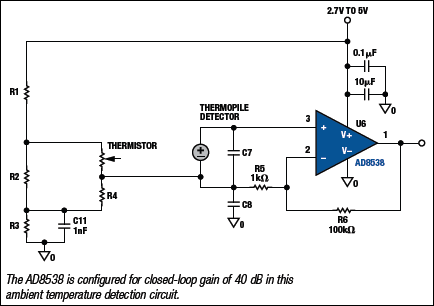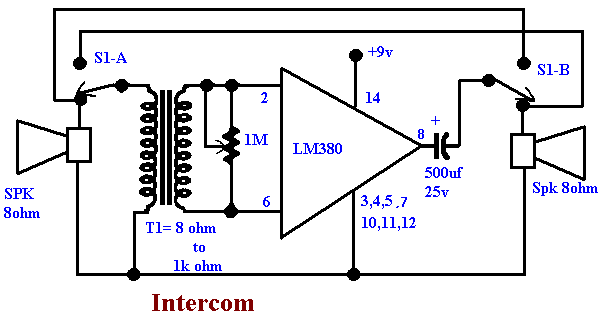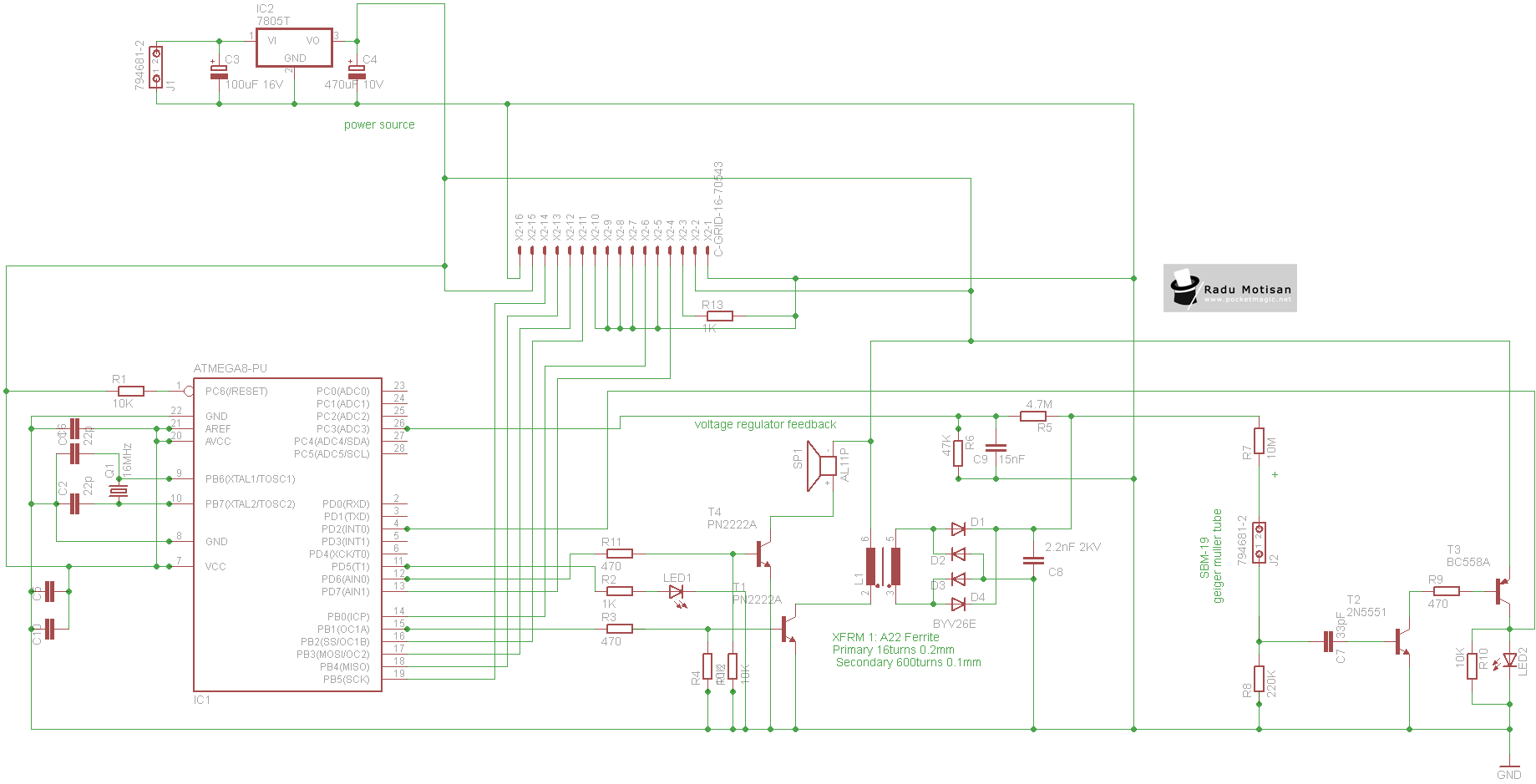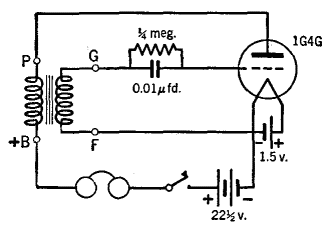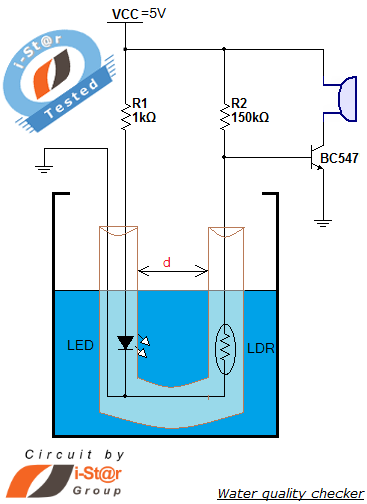
Simple Stereo VU Meter
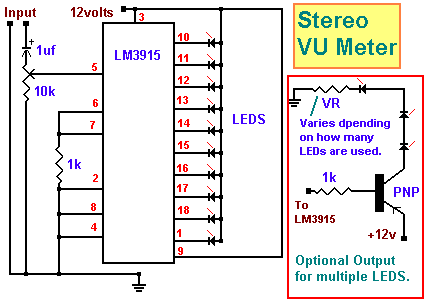
This project indicates the audio volume level going to speakers by illuminating LEDs. The LEDs can be of any color, allowing for creative combinations. The circuit input is connected to the speaker output of an audio amplifier. Two identical units should be built to represent both the right and left audio channels. The input signal level is adjustable using a 10k ohm variable resistor (VR). For those interested in creating a large-scale version of this unit to display on a wall, an optional output transistor is available to drive multiple LEDs simultaneously. The constructed unit can illuminate three LEDs for each output, following the lighting sequence: Pin 1, 18, 17, 16, 15, 14, 13, 12, 11, 10.
This audio level indicator circuit utilizes LEDs to visually represent the volume levels of audio signals from an amplifier. The design requires two identical circuits to monitor both the left and right audio channels, ensuring a comprehensive audio visualization. The input connection is made to the speaker output of the amplifier, which allows the circuit to respond to the audio signal levels directly.
The core component of the circuit is a 10k ohm variable resistor (VR), which enables the user to adjust the sensitivity of the input signal. This feature is essential for tailoring the circuit's response to different audio sources and desired brightness levels of the LEDs. The flexibility of using various colored LEDs enhances the aesthetic appeal of the project, allowing for a customized display.
For larger installations, an optional output transistor can be integrated into the design. This transistor serves to amplify the current, allowing the circuit to drive multiple LEDs concurrently, which is particularly useful for larger displays or installations. The capability to light up three LEDs per channel provides a dynamic visual representation of audio levels, with the sequence of illumination carefully designed to create an engaging effect.
The lighting sequence for the LEDs is predetermined, following a specific order: Pin 1, 18, 17, 16, 15, 14, 13, 12, 11, and 10. This sequence ensures a smooth transition of lights, reflecting the audio signal's amplitude in a visually appealing manner. Overall, this project combines functionality with creativity, resulting in an attractive and informative audio level indicator.This project will indicate the volume level of the audio going to your speakers by lighting up LEDS. The LEDS can be any color so mix them up and really make it look good. The input of the circuit is connected to the speaker output of your audio amplifier. You want to build two identical units to indicate both right and left channels. The input signal level is adjusted by the 10k ohm VR. If you wish to make a very large scale model of this unit and hang it on your wall there is an optional output transistor that can drive many LEDS at once. The unit I built drove three LEDS for each output. The sequence of the LEDS lighting are as follows Pin 1, 18, 17, 16, 15, 14, 13, 12, 11, 10. 🔗 External reference
This audio level indicator circuit utilizes LEDs to visually represent the volume levels of audio signals from an amplifier. The design requires two identical circuits to monitor both the left and right audio channels, ensuring a comprehensive audio visualization. The input connection is made to the speaker output of the amplifier, which allows the circuit to respond to the audio signal levels directly.
The core component of the circuit is a 10k ohm variable resistor (VR), which enables the user to adjust the sensitivity of the input signal. This feature is essential for tailoring the circuit's response to different audio sources and desired brightness levels of the LEDs. The flexibility of using various colored LEDs enhances the aesthetic appeal of the project, allowing for a customized display.
For larger installations, an optional output transistor can be integrated into the design. This transistor serves to amplify the current, allowing the circuit to drive multiple LEDs concurrently, which is particularly useful for larger displays or installations. The capability to light up three LEDs per channel provides a dynamic visual representation of audio levels, with the sequence of illumination carefully designed to create an engaging effect.
The lighting sequence for the LEDs is predetermined, following a specific order: Pin 1, 18, 17, 16, 15, 14, 13, 12, 11, and 10. This sequence ensures a smooth transition of lights, reflecting the audio signal's amplitude in a visually appealing manner. Overall, this project combines functionality with creativity, resulting in an attractive and informative audio level indicator.This project will indicate the volume level of the audio going to your speakers by lighting up LEDS. The LEDS can be any color so mix them up and really make it look good. The input of the circuit is connected to the speaker output of your audio amplifier. You want to build two identical units to indicate both right and left channels. The input signal level is adjusted by the 10k ohm VR. If you wish to make a very large scale model of this unit and hang it on your wall there is an optional output transistor that can drive many LEDS at once. The unit I built drove three LEDS for each output. The sequence of the LEDS lighting are as follows Pin 1, 18, 17, 16, 15, 14, 13, 12, 11, 10. 🔗 External reference
